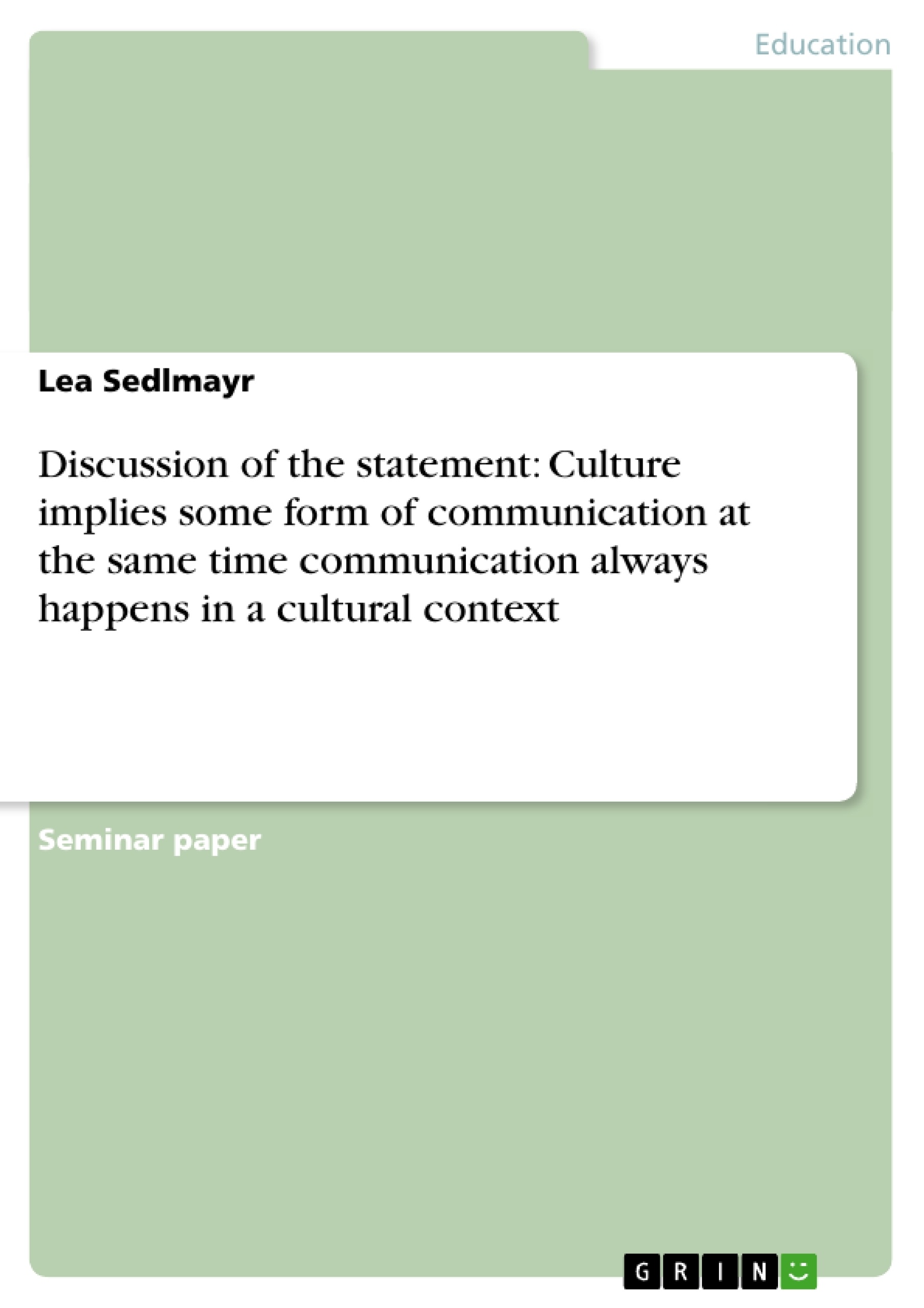Extracto
Content
Introduction
Classification of Culture
Culture Theories
Thick Description
Cultural Self-Understanding
Conclusion
Literature
Introduction
Culture implies some form of communication at the same time communication always happens in a cultural context.
This statement can be seen in many different ways and connected to different disciplines of science. Alone the definition of culture fills up many books. I will try to start a discussion based on a few theories we talked about in our culture education science class of Åsle Hogmø and Jens-Ivar Negård 2003.
Of course it can only be a short look in this idea-constructs and a quite incomplete overview, but nevertheless there are interesting and important components connected to this simple looking statement which mirrors itself in a way, that there is an implication of the two notions to each other.
But first of all I want to start with giving a short definition of the notions: I have here translated the word formidling or Vermittlung with communication. Because I did not find a direct translation I chose communication, which contents the whole meaning of formidling how I understand it.
The Oxford Dictionary[1] explains “to communicate” (from the origin of “common”) “to make common to many, to share to impart”. This can have the meaning of “to give to another as a partaker”, in a form of transmission, as well as “to have a common part, to take part”. I think it is important to take these two views on the content of communication, because it is always based on the two sides of getting and giving. Communication also means, “to impart information”, “to inform a person” or “to impart by way of information to a society”, which means to make communication[2]. For this essay I want to keep this open and general view on this notion.
After this input from a usual dictionary, I want to turn to the other notion, culture. In this case I want to hold a close connection to an article of Klausen[3], in which he shows the long history and tradition of this word, which is still much in use and often called not possible to define. But under all the opportunities of using this notion, there are two main streams in the western world: Klausen called them “verdiorientierte” and “beskrivende”[4] culture-definition. The first one comes from the original use of the verb to refine and is used today to describe a whole sector of the modern society including its own institutions and an own state administration.
It is the second definition that the interesting one in this context, because it refers to ”hvordan ting er”[5] and Klausen describes this definition as the anthropological or social-scientific notion of culture:
“Vi kan derfor definere det beskrivende kulturbegrep på en presis måte slik: de ideer, verdier, regler, normer, koder og symboler som et menneske overtar fra den foregående generasjon, og som man forsøker å bringe videre – oftest noe forandret – til den neste generasjon”[6].
Klausen shows the connection of teaching and learning between parents and children, teachers and pupils, with language and communication as the central aspects. This process of socialisation also includes the cultural contact to other societies and their codes – codes that are probably deferring from the own one[7]. In connection to that I want to mention Margaret Mead and her system of classification of cultural transmission between generations.
Classification of Culture
“Culture may be seen as a process through which man creates his living environment and is able to improve it progressively by retaining and modifying advances made by previous generations, teaching the whole subsequent generations, borrowing innovations made by other groups and making innovations which are capable perpetuation”[8].
Based on this general sense of culture, M. Mead classifies culture in three categories:
The first category is named “postfigurative cultures”[9]: The older generation communicates experiences of their own past to the younger generation, expecting nothing else for the future. This form of culture has been characteristic for the human society since ancient times, providing it with continuity and traditions and leaving it without a realisation of change. M Mead calls “the isolated primitive culture” “the prototype postfigurative culture”[10].
The term “Configurative cultures”[11] describes a society, where the transmission happens within one generation and is marked by a “break of generations”[12]. This means, that the older generation will never experience, what the younger generation does and the other way round. A good example of our modern times is the subcultures of the youth (like for example popmusic) – every generation has its own kind of culture and their own codes.
[...]
[1] Simpson, J. A. & Weiner, E. S. C., 1989: The Oxford Dictionary, Second Edition, Volume III, cham-creeky. Oxford: Clarendon Press. (Page 577/578)
[2] all quotations from Simpson, J. A. & Weiner, E. S. C: op. cit. (577/578)
[3] Klausen, A. M., 1992: Kulturbegrep og Kulturfag, i Kultur. Mønster og kaos. Oslo: ad Notam/Gyldendal.
[4] Klausen: op. cit. (Page 25)
[5] Klausen: op. cit (Page 25)
[6] Klausen: op. cit. (Page 27) – based on E. B. Tylors definition of 1871
[7] Klausen: op. cit. (Page 29)
[8] Mead, M., 1964: Continuities in Cultural Evolution. New Haven/London: Yale University Press. (Page 36)
[9] Mead, M., 1978: Culture and Commitment. The New Relationships Between The Generations in the 1970s. New York; Columbia University Press. (Page 13)
[10] Mead, M., 1978: op. cit. (Page 29)
[11] Mead, M., 1978: op. cit. (Page 39)
[12] Mead, M. 1978: op. cit. (Page 64)
- Citar trabajo
- Lea Sedlmayr (Autor), 2003, Discussion of the statement: Culture implies some form of communication at the same time communication always happens in a cultural context, Múnich, GRIN Verlag, https://www.grin.com/document/79145
Así es como funciona






















Comentarios